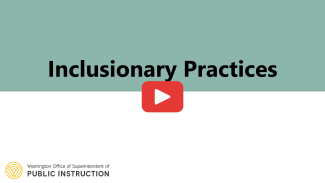Comprehensive Inclusive Education
Inclusive education for students who receive special education services involves both access and learning in general education and the inclusive Individualized Education Program (IEP). All members of a student’s educational team, including the student and their family, have a role to play in effective instruction and support in inclusive settings.
Download the guide, Comprehensive Inclusive Education in Washington, for a step-by-step process to develop inclusive IEPs and promote equitable learning opportunities and post-school outcomes for students eligible for special education services.

OSPI affirms the following principles in this work:
- Every student is a general education student.
- The IEP is not the student’s entire educational program or curriculum. For a student eligible for special education services, their education program has three parts:
- The general education curriculum
- The school’s routines and activities
- The IEP
- Students learn and thrive when they are valued, visible members of their classroom and school communities and activities.
Step 1: Collaborative Conversations
Collaborate with the family and school team for a solid foundation to start the school year.
Step 2: Creating an Inclusive IEP
Develop an IEP that honors student and family voice and intentionally aligns supports to the general education settings, curriculum, routines, activities, and social opportunities that are available for all students in the school.
Step 3: Education Day-at-a-Glance
Efficiently implement the IEP by linking goals and supports with the student’s daily schedule.
Step 4: Ongoing Education and Support
Continually collaborate to implement the IEP and ensure all students are learning.
Using This Resource
This resource is designed for flexibility. Use it to:
- Follow the step-by-step process to write and implement inclusive IEPs for students with disabilities, particularly those with extensive support needs
- Learn from the story of “Jacob,” a student with extensive support needs, as his instructional team develops his inclusive IEP and implements an inclusive educational program across the school day
- Understand the rationale for inclusionary practices and high-quality special education services for students with disabilities, including state requirements and a recent Supreme Court decision
- Connect to practical resources and related content for each step on OSPI’s website
- Adapt the information in this resource for local districts to support professional development, policies, procedures, and practices that result in improved inclusive IEPs and implementation of high quality inclusive education programs
Acknowledgments
Comprehensive Inclusive Education in Washington © 2024 by the Washington Office of Superintendent of Public Instruction (OSPI) and the TIES Center is licensed under CC BY-NC-SA 4.0. To view a copy of this license, visit CC BY-NC-SA 4.0.
This website may contain links to websites operated by third parties. These links are provided for your convenience only and do not constitute or imply any endorsement or monitoring by OSPI.
The example of “Jacob” in Comprehensive Inclusive Education in Washington is based on a compilation of students. A special thank you of appreciation is extended to the Washington family who generously permitted the photos of their son and his inclusive educational experiences at Ruby Bridges Elementary School in Woodinville, WA to be included in this resource. The photos beautifully illustrate what inclusive education might look like.
Comprehensive Inclusive Education in Washington is adapted from Comprehensive Inclusive Education: General Education and the Inclusive IEP, originally developed through a partnership between the TIES Center and the University of Washington Haring Center for Inclusive Education. TIES Center (2017-2022) was supported primarily through a Cooperative Agreement (#H326Y170004) with the Research to Practice Division, Office of Special Education Programs, U.S. Department of Education. Opinions expressed in this guide do not necessarily reflect those of the U.S. Department of Education or Offices within it. Project Officer: Susan Weigert. All rights reserved.






